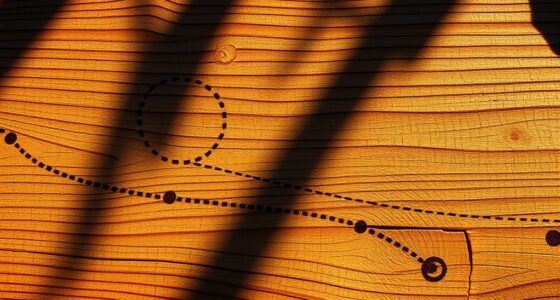Vanuatu’s land-diving ritual blends deep cultural beliefs with physics to create a powerful tradition. You see, it’s about honoring ancestors, seeking spiritual protection, and celebrating community pride. Divers jump from tall wooden towers, with safety guaranteed by their understanding of vine elasticity and body movement—an instinctive use of physics. This practice isn’t just physical; it’s a sacred act rooted in tradition, resilience, and spiritual meaning. Explore further to discover how anthropology and physics intertwine in this striking ritual.
Key Takeaways
- The land-diving ritual is rooted in Vanuatu’s cultural beliefs to honor ancestors and ensure spiritual protection and prosperity.
- Physically, divers jump from tall towers using vines, with traditional knowledge guiding safety through body weight distribution and elasticity.
- The ritual fosters community bonding, pride, and serves as a rite of passage, reinforcing cultural identity and resilience.
- Spiritual beliefs integrate physics principles, viewing the dive as a sacred offering that combines cultural significance with physical safety.
- Modern safety practices maintain tradition’s relevance while minimizing risks, illustrating the blend of anthropology, physics, and cultural continuity.

Have you ever wondered how ancient traditions continue to captivate and challenge communities today? The Vanuatu land-diving ritual offers a powerful glimpse into how traditional beliefs shape behavior and influence both individual and collective psychology. For the people of Vanuatu, these daring jumps aren’t just acts of bravery—they’re deeply rooted in cultural identity and spiritual significance. They believe that by performing these land-dives, they honor their ancestors, seek protection from spirits, and ensure a bountiful future. These traditional beliefs create a framework where risking physical danger becomes a sacred duty, reinforcing social bonds and cultural continuity. The psychological effects of participating in or witnessing these dives are profound. Many divers experience a mix of adrenaline, fear, and pride, which heightens their sense of connection to their community and tradition. The ritual becomes a rite of passage, instilling confidence and fostering a collective sense of achievement. It’s not merely about physical daring; it’s about affirming one’s place within their cultural universe, often leading to a sense of spiritual fulfillment. From a psychological standpoint, these rituals serve as a way to cope with life’s uncertainties, offering a structured expression of courage and resilience. The community’s shared participation amplifies these effects, creating a collective identity rooted in tradition and shared history. The physical act of jumping from towering wooden towers, sometimes exceeding 20 meters, might seem purely daring to outsiders, but for the locals, it’s a sacred act guided by centuries-old beliefs. They trust in spiritual forces to protect them, and their confidence is reinforced through communal support and ritual preparation. The physics behind the land-diving, involving the distribution of body weight and the elasticity of the vines, guarantees safety despite the apparent danger. Interestingly, modern safety measures such as the careful selection of vines and meticulous preparation are incorporated to preserve the tradition while minimizing risks. Yet, it’s the cultural and psychological context that transforms this act into a meaningful ritual. It’s fascinating to see how these traditional beliefs shape the way individuals approach risk—viewing it as a spiritual offering rather than reckless behavior. The psychological effects extend beyond individual divers; spectators and community members often experience a collective sense of pride, awe, and spiritual connection. This ritual embodies a complex interplay between physics, anthropology, and psychology, illustrating how long-standing traditions continue to resonate in modern times. It’s a vivid reminder that cultural practices are not just relics of the past—they’re living expressions of identity, values, and spiritual beliefs that continue to influence communities today.
Frequently Asked Questions
How Do Participants Mentally Prepare for the Dive?
You mentally prepare for the dive by cultivating meditative focus, centering your thoughts, and calming your mind. This helps build mental resilience, allowing you to face the leap with confidence. You might engage in breathing exercises or visualization techniques to strengthen your focus and reduce fear. By doing so, you reinforce your mental strength, ensuring you’re fully present and prepared to undertake the jump with clarity and courage.
What Are the Traditional Beliefs Associated With the Ritual?
You believe that the land-diving ritual holds deep spiritual symbolism, representing a connection to your ancestors and nature. These traditional beliefs emphasize that the dive honors ancestral spirits, seeking their blessing for prosperity and protection. You see it as a sacred act that reinforces community bonds and spiritual ties, where each jump embodies reverence for your heritage and the divine forces believed to influence your well-being.
How Has the Ritual Evolved Over the Past Century?
Over the past century, you’ll notice significant historical changes in land-diving, influenced by modernization and external influences. Despite these shifts, efforts for cultural preservation keep the ritual alive, blending tradition with adaptation. You might see new materials or ceremonies, but the core meaning remains intact. These changes show how the community balances honoring their heritage while embracing progress, ensuring the ritual’s survival for future generations.
Are There Any Safety Measures or Precautions?
You should know that safety measures are essential during land-diving. Participants often wear safety gear like mats or soft ground to reduce injury risk, and organizers emphasize risk management practices. They carefully select sites, monitor jumpers’ health, and limit jump heights for safety. These precautions help minimize dangers, but inherent risks remain. Always respect these safety measures and understand the risks involved before participating or observing this intense, traditional ritual.
What Is the Significance of the Ritual in Contemporary Vanuatu Society?
You might find it fascinating that over 70% of Vanuatu’s population still practices land-diving, highlighting its essential cultural importance. In contemporary society, the ritual symbolizes cultural preservation and identity amidst modern adaptation. It connects communities to their ancestors, reinforces social bonds, and celebrates tradition. Despite changes, land-diving remains a powerful expression of cultural pride, ensuring this unique practice continues to thrive while blending tradition with modern influences.
Conclusion
As you stand beneath the towering canopies of tradition, you realize that Vanuatu’s land-diving isn’t just a daring act but a tapestry woven with physics and culture. It’s a dance between human courage and natural laws, like a symphony where physics plays the melody, and tradition provides the rhythm. This ritual reminds you that beneath every leap, there’s a story rooted in history and science, making it a breathtaking bridge between mind and myth.









